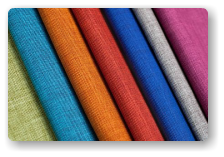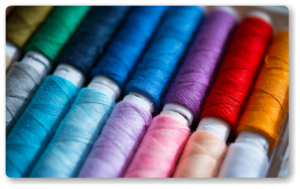Understanding Textile Manufacturing Process in the light of Textile Wastewater Types and Chemicals Used
 Textile industry deploys many different process stages in its manufacturing life cycle which involves both mechanical processing and wet-treatment processes. The mechanical processes are spinning, knitting, weaving and garment production. The wet processes are sizing, desizing, scouring, bleaching, mercerizing, dyeing, printing and finishing. Table 1 lists the types of waste generated in every stage of textile production.
Textile industry deploys many different process stages in its manufacturing life cycle which involves both mechanical processing and wet-treatment processes. The mechanical processes are spinning, knitting, weaving and garment production. The wet processes are sizing, desizing, scouring, bleaching, mercerizing, dyeing, printing and finishing. Table 1 lists the types of waste generated in every stage of textile production.
Table 1. Types of Textile Waste Produced by Process (Water, Solid and Emission)
| Process | Wastewater | Solid Waste | Emission |
|---|---|---|---|
| Fiber preparation | Little or none | Fiber waste and packaging waste | Little or none |
| Yarn spinning | Little or none | Packaging wastes, sized yarn, fiber waste, cleaning and processing waste | Little or none |
| Sizing | BOD, COD, metals, cleaning waste, size | Fiber lint, yarn waste, packaging waste, unused starch-based sizes | VOCs |
| Weaving | Little or none | Packaging waste, yarn and fabric scarps, used oil | Little or none |
| Knitting | Little or none | Packaging waste, yarn and fabric scarps | Little or none |
| Tufting | Little or none | Packaging waste, yarn and fabric scarps, offspec fabric | Little or none |
| Desizing | BOD from sizes lubricants, | Packaging waste, fabric | VOCs from glycol esters |
| biocides, anti-static compounds | lint, yarn waste, cleaning and maintenance materials | ||
| Scouring | Disinfectants, insecticide recisues, NaOH, detergents oils, knitting lubricants, spin finishes, spent solvents | Little or none | VOCs from glycol esters and scouring solvents |
| Bleaching | H2O2, stabilizers, high pH | Little or none | Little or none |
| Singeing | Little or none | Little or none | small amounts of exhaust gasses from the burners exhausted with components |
| Mercerizing | High pH, NaOH | Little or none | Little or none |
| Heat setting | Little or none | Little or none | volatilization of spin finish agents-synthetic fiber manufacture |
| Dyeing | Metals, salt, surfactants, organic processing, assistants, cationic materials, color, BOD, COD, sulphide, acidity/alkalinity, spent solvents | Little or none | VOCs |
| Printing | Suspended solids, urea, solvents, color, metals, heat, BOD, foam | Little or none | solvents, acetic acid – drying and curing oven emission combustion gasses |
| Finishing | COD, suspended solids, toxic materials, spent solvents | Fabric scraps and trimmings, packaging waste | VOCs, contaminants in purchased chemicals, formaldehyde vapours, combustion gasses |
 A variety of chemicals are used in each and every stage of the production process of textiles. These chemicals end up as waste once their intended function is achieved in the production process. These spent up chemicals end up as effluent and need to be treated accordingly for a stricter compliance of the rules and regulations of Wastewater Management of the State. Table 2 lists down the type of chemicals used in each stage of the production process.
A variety of chemicals are used in each and every stage of the production process of textiles. These chemicals end up as waste once their intended function is achieved in the production process. These spent up chemicals end up as effluent and need to be treated accordingly for a stricter compliance of the rules and regulations of Wastewater Management of the State. Table 2 lists down the type of chemicals used in each stage of the production process.
Table 2: Chemicals Used in Different Production Processes In Textile Manufacturing
| PROCESS STEP | PROCESS NAME | PROCESS DETAIL | CHEMICALS USED |
|---|---|---|---|
| STEP 1 | FIBRE PRODUCTION | Plant fibres are produced from Cotton, linen, hemp, bamboo and any other plants with extractable cellulose. | pesticides, insecticides, fertilisers |
| STEP 1 | FIBRE PRODUCTION | Animal fibres are made up of proteins and commonly used animal fibres are wool and silk | pesticides, insecticides, scouring chemicals |
| STEP 1 | FIBRE PRODUCTION | Man-made fibres are based on cellulose extracted from wood pulp and common one is viscose (rayon). | acids, bases, process chemicals |
| STEP 1 | FIBRE PRODUCTION | Synthetic fibres are produced from monomers sourced from fossil oils and common one is polyester. | petroleum-based feedstock, dyes, pigments, catalysts, stabilizers |
| STEP 2 | YARN PRODUCTION | The collected fibres are spun into yarn which is a mechanical production process. To increase the strength of the fibre, fibre cohesion and reduce friction, spinning oils are added. | spinning oils |
| STEP 3 | FABRIC PRODUCTION | Weaving | sizing chemicals |
| STEP 3 | FABRIC PRODUCTION | Knitting | lubricants |
| STEP 3 | FABRIC PRODUCTION | Non-woven | solvents, adhesives, binders |
| STEP 4 | PRE-TREATMENT | Washing (cleaning of the fabric) | Detergents, solvents |
| STEP 4 | PRE-TREATMENT | De-Sizing (removing the sizing chemicals from the warp) | Enzymes |
| STEP 4 | PRE-TREATMENT | Scouring (Removing fatty waxes and greases from natural fibres) | Detergents, bases, solvents |
| STEP 4 | PRE-TREATMENT | Bleaching (Making the fibre whiter to make the fibres more absorbent) | Bleaches |
| STEP 4 | PRE-TREATMENT | Mercerizing (making cellulosic fibres strong and swell to facilitate dyeing) | Bases |
| STEP 4 | PRE-TREATMENT | Carbonizing (removes vegetable residues) | Acids |
| STEP 5 | DYEING & PRINTING | Dyeing | Dyes, Pigments |
| STEP 5 | DYEING & PRINTING | Printing | pigments, dyes, binders and polymeric resin (acrylates, PVC, PUR), plasticisers |
| STEP 5 | DYEING & PRINTING | Washing | Detergents |
| STEP 6 | FINISHING TREATMENTS | Handle modification | Softeners (polyetylen, quartenary ammonium compounds, silicones, polyurethanes) |
| STEP 6 | FINISHING TREATMENTS | Handle modification | Stiffeners (starches resins, polyvinylacetat, polyvinylalcohol) |
| STEP 6 | FINISHING TREATMENTS | Crease resistance (anti-wrinkling, easy care) | Resins, Formaldehyde based |
| STEP 6 | FINISHING TREATMENTS | Antistatic treatment | cationic softeners, polyglycols |
| STEP 6 | FINISHING TREATMENTS | Anti-pilling | resins |
| STEP 6 | FINISHING TREATMENTS | Antibacterial/anti-odor treatment | biocides as silver, triclosane |
| STEP 6 | FINISHING TREATMENTS | Water repellance | water repellents based on waxes, silicones, fluorocarbons |
| STEP 6 | FINISHING TREATMENTS | Oil/soil repellance | oil/soil repellents based on fluorocabons |
| STEP 6 | FINISHING TREATMENTS | Flame retardance | flame retardants (halogenated, phosphor based) |
| STEP 6 | FINISHING TREATMENTS | (Protective) coatings | Acrylates, polyurethanes, silcones, PVC with plasticisers |
| STEP 6 | FINISHING TREATMENTS | Laminated films and membranes | in the material layers: Different types of polymers (polyurethane, polytetrafluoretylen, modified polyester) |
| STEP 6 | FINISHING TREATMENTS | Laminated films and membranes | in adhesives: Different types of polymers such as polyurethane based, and thermoplastic polymers |
| STEP 6 | FINISHING TREATMENTS | Garment treatments for fashion | Potassium permanganate, sodium hypochlorite, calcium hypochlorite, sodium hydro sulphite, potassium dichromate, formaldehyde resins, cationic softeners, cationic silicone softeners |
| STEP 7 | TRANSPORT & STORAGE | Transport Preparation | Dimethyl fumarate, ethylene oxide, methylbromide, 1,2 dichloroethane, phospine, dichloromethane, sulfuryl fluoride |
To produce a kilogram of textiles, approximately 200 litre of water is utilized. Ntuli F, Omoregbe I, Kuipa P, Muzenda E, Belaid M (2009) have reported a concise percentage split of water used in a textile manufacturing process: “38 % of water is used during process of bleaching, 16 % in dyeing, 8% in printing, 14 % in boiler and 24 % for other uses”. The textile wastewater effluent contains high amounts of suspended and dissolved solids, biological oxygen demand (BOD), chemical oxygen demand (COD), chemicals, trace metals like Cr, As, Cu and Zn and color.
Hence it is a mandate to treat the textile wastewater with right care and technology to safeguard the environment.



